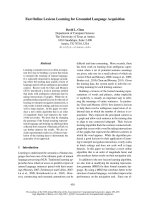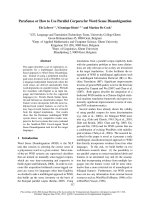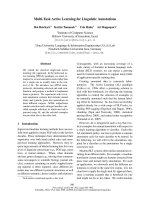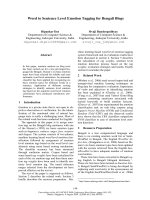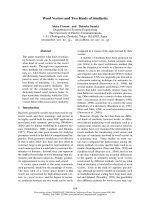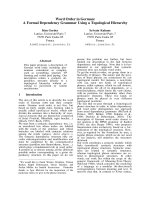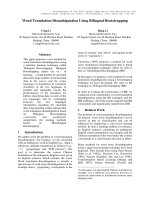Báo cáo khoa học: "Word or Phrase? Learning Which Unit to Stress for Information Retrieval∗" doc
Bạn đang xem bản rút gọn của tài liệu. Xem và tải ngay bản đầy đủ của tài liệu tại đây (762.19 KB, 9 trang )
Proceedings of the 47th Annual Meeting of the ACL and the 4th IJCNLP of the AFNLP, pages 1048–1056,
Suntec, Singapore, 2-7 August 2009.
c
2009 ACL and AFNLP
Word or Phrase?
Learning Which Unit to Stress for Information Retrieval
∗
Young-In Song
†
and Jung-Tae Lee
‡
and Hae-Chang Rim
‡
†
Microsoft Research Asia, Beijing, China
‡
Dept. of Computer & Radio Communications Engineering, Korea University, Seoul, Korea
†
, {jtlee,rim}@nlp.korea.ac.kr
‡
Abstract
The use of phrases in retrieval models has
been proven to be helpful in the literature,
but no particular research addresses the
problem of discriminating phrases that are
likely to degrade the retrieval performance
from the ones that do not. In this paper, we
present a retrieval framework that utilizes
both words and phrases flexibly, followed
by a general learning-to-rank method for
learning the potential contribution of a
phrase in retrieval. We also present use-
ful features that reflect the compositional-
ity and discriminative power of a phrase
and its constituent words for optimizing
the weights of phrase use in phrase-based
retrieval models. Experimental results on
the TREC collections show that our pro-
posed method is effective.
1 Introduction
Various researches have improved the quality
of information retrieval by relaxing the tradi-
tional ‘bag-of-words’ assumption with the use of
phrases. (Miller et al., 1999; Song and Croft,
1999) explore the use n-grams in retrieval mod-
els. (Fagan, 1987; Gao et al., 2004; Met-
zler and Croft, 2005; Tao and Zhai, 2007) use
statistically-captured term dependencies within a
query. (Strzalkowski et al., 1994; Kraaij and
Pohlmann, 1998; Arampatzis et al., 2000) study
the utility of various kinds of syntactic phrases.
Although use of phrases clearly helps, there still
exists a fundamental but unsolved question: Do all
phrases contribute an equal amount of increase in
the performance of information retrieval models?
Let us consider a search query ‘World Bank Crit-
icism’, which has the following phrases: ‘world
∗
This work was done while Young-In Song was with the
Dept. of Computer & Radio Communications Engineering,
Korea University.
bank’ and ‘bank criticism’. Intuitively, the for-
mer should be given more importance than its con-
stituents ‘world’ and ‘bank’, since the meaning
of the original phrase cannot be predicted from
the meaning of either constituent. In contrast, a
relatively less attention could be paid to the lat-
ter ‘bank criticism’, because there may be alter-
nate expressions, of which the meaning is still pre-
served, that could possibly occur in relevant docu-
ments. However, virtually all the researches ig-
nore the relation between a phrase and its con-
stituent words when combining both words and
phrases in a retrieval model.
Our approach to phrase-based retrieval is moti-
vated from the following linguistic intuitions: a)
phrases have relatively different degrees of signif-
icance, and b) the influence of a phrase should be
differentiated based on the phrase’s constituents in
retrieval models. In this paper, we start out by
presenting a simple language modeling-based re-
trieval model that utilizes both words and phrases
in ranking with use of parameters that differenti-
ate the relative contributions of phrases and words.
Moreover, we propose a general learning-to-rank
based framework to optimize the parameters of
phrases against their constituent words for re-
trieval models that utilize both words and phrases.
In order to estimate such parameters, we adapt the
use of a cost function together with a gradient de-
scent method that has been proven to be effective
for optimizing information retrieval models with
multiple parameters (Taylor et al., 2006; Metzler,
2007). We also propose a number of potentially
useful features that reflect not only the characteris-
tics of a phrase but also the information of its con-
stituent words for minimizing the cost function.
Our experimental results demonstrate that 1) dif-
ferentiating the weights of each phrase over words
yields statistically significant improvement in re-
trieval performance, 2) the gradient descent-based
parameter optimization is reasonably appropriate
1048
to our task, and 3) the proposed features can dis-
tinguish good phrases that make contributions to
the retrieval performance.
The rest of this paper is organized as follows.
The next section discusses previous work. Section
3 presents our learning-based retrieval framework
and features. Section 4 reports the evaluations of
our techniques. Section 5 finally concludes the pa-
per and discusses future work.
2 Previous Work
To date, there have been numerous researches to
utilize phrases in retrieval models. One of the
most earliest work on phrase-based retrieval was
done by (Fagan, 1987). In (Fagan, 1987), the ef-
fectiveness of proximity-based phrases (i.e. words
occurring within a certain distance) in retrieval
was investigated with varying criteria to extract
phrases from text. Subsequently, various types
of phrases, such as sequential n-grams (Mitra et
al., 1997), head-modifier pairs extracted from syn-
tactic structures (Lewis and Croft, 1990; Zhai,
1997; Dillon and Gray, 1983; Strzalkowski et al.,
1994), proximity-based phrases (Turpin and Mof-
fat, 1999), were examined with conventional re-
trieval models (e.g. vector space model). The ben-
efit of using phrases for improving the retrieval
performance over simple ‘bag-of-words’ models
was far less than expected; the overall perfor-
mance improvement was only marginal and some-
times even inconsistent, specifically when a rea-
sonably good weighting scheme was used (Mitra
et al., 1997). Many researchers argued that this
was due to the use of improper retrieval models
in the experiments. In many cases, the early re-
searches on phrase-based retrieval have only fo-
cused on extracting phrases, not concerning about
how to devise a retrieval model that effectively
considers both words and phrases in ranking. For
example, the direct use of traditional vector space
model combining a phrase weight and a word
weight virtually yields the result assuming inde-
pendence between a phrase and its constituent
words (Srikanth and Srihari, 2003).
In order to complement the weakness, a number
of research efforts were devoted to the modeling
of dependencies between words directly within re-
trieval models instead of using phrases over the
years (van Rijsbergen, 1977; Wong et al., 1985;
Croft et al., 1991; Losee, 1994). Most stud-
ies were conducted on the probabilistic retrieval
framework, such as the BIM model, and aimed on
producing a better retrieval model by relaxing the
word independence assumption based on the co-
occurrence information of words in text. Although
those approaches theoretically explain the relation
between words and phrases in the retrieval con-
text, they also showed little or no improvements
in retrieval effectiveness, mainly because of their
statistical nature. While a phrase-based approach
selectively incorporated potentially-useful relation
between words, the probabilistic approaches force
to estimate parameters for all possible combina-
tions of words in text. This not only brings
parameter estimation problems but causes a re-
trieval system to fail by considering semantically-
meaningless dependency of words in matching.
Recently, a number of retrieval approaches have
been attempted to utilize a phrase in retrieval mod-
els. These approaches have focused to model sta-
tistical or syntactic phrasal relations under the lan-
guage modeling method for information retrieval.
(Srikanth and Srihari, 2003; Maisonnasse et al.,
2005) examined the effectiveness of syntactic re-
lations in a query by using language modeling
framework. (Song and Croft, 1999; Miller et al.,
1999; Gao et al., 2004; Metzler and Croft, 2005)
investigated the effectiveness of language model-
ing approach in modeling statistical phrases such
as n-grams or proximity-based phrases. Some of
them showed promising results in their experi-
ments by taking advantages of phrases soundly in
a retrieval model.
Although such approaches have made clear dis-
tinctions by integrating phrases and their con-
stituents effectively in retrieval models, they did
not concern the different contributions of phrases
over their constituents in retrieval performances.
Usually a phrase score (or probability) is simply
combined with scores of its constituent words by
using a uniform interpolation parameter, which
implies that a uniform contribution of phrases
over constituent words is assumed. Our study is
clearly distinguished from previous phrase-based
approaches; we differentiate the influence of each
phrase according to its constituent words, instead
of allowing equal influence for all phrases.
3 Proposed Method
In this section, we present a phrase-based retrieval
framework that utilizes both words and phrases ef-
fectively in ranking.
1049
3.1 Basic Phrase-based Retrieval Model
We start out by presenting a simple phrase-based
language modeling retrieval model that assumes
uniform contribution of words and phrases. For-
mally, the model ranks a document D according to
the probability of D generating phrases in a given
query Q, assuming that the phrases occur indepen-
dently:
s(Q; D) = P (Q|D) ≈
|Q|
i=1
P (q
i
|q
h
i
, D) (1)
where q
i
is the ith query word, q
h
i
is the head word
of q
i
, and |Q| is the query size. To simplify the
mathematical derivations, we modify Eq. 1 using
logarithm as follows:
s(Q; D) ∝
|Q|
i=1
log[P (q
i
|q
h
i
, D)] (2)
In practice, the phrase probability is mixed with
the word probability (i.e. deleted interpolation) as:
P (q
i
|q
h
i
,D)≈λP (q
i
|q
h
i
,D)+(1−λ)P (q
i
|D) (3)
where λ is a parameter that controls the impact of
the phrase probability against the word probability
in the retrieval model.
3.2 Adding Multiple Parameters
Given a phrase-based retrieval model that uti-
lizes both words and phrases, one would definitely
raise a fundamental question on how much weight
should be given to the phrase information com-
pared to the word information. In this paper, we
propose to differentiate the value of λ in Eq. 3
according to the importance of each phrase by
adding multiple free parameters to the retrieval
model. Specifically, we replace λ with well-
known logistic function, which allows both nu-
merical and categorical variables as input, whereas
the output is bounded to values between 0 and 1.
Formally, the input of a logistic function is a
set of evidences (i.e. feature vector) X generated
from a given phrase and its constituents, whereas
the output is the probability predicted by fitting X
to a logistic curve. Therefore, λ is replaced as fol-
lows:
λ(X) =
1
1 + e
−f(X)
· α (4)
where α is a scaling factor to confine the output to
values between 0 and α.
f(X) = β
0
+
|X|
i=1
β
i
x
i
(5)
where x
i
is the ith feature, β
i
is the coefficient pa-
rameter of x
i
, and β
0
is the ‘intercept’, which is
the value of f(X) when all feature values are zero.
3.3 RankNet-based Parameter Optimization
The β parameters in Eq. 5 are the ones we wish
to learn for resulting retrieval performance via pa-
rameter optimization methods. In many cases, pa-
rameters in a retrieval model are empirically de-
termined through a series of experiments or auto-
matically tuned via machine learning to maximize
a retrieval metric of choice (e.g. mean average
precision). The most simple but guaranteed way
would be to directly perform brute force search
for the global optimum over the entire parame-
ter space. However, not only the computational
cost of this so-called direct search would become
undoubtfully expensive as the number of parame-
ters increase, but most retrieval metrics are non-
smooth with respect to model parameters (Met-
zler, 2007). For these reasons, we propose to adapt
a learning-to-rank framework that optimizes mul-
tiple parameters of phrase-based retrieval models
effectively with less computation cost and without
any specific retrieval metric.
Specifically, we use a gradient descent method
with the RankNet cost function (Burges et al.,
2005) to perform effective parameter optimiza-
tions, as in (Taylor et al., 2006; Metzler, 2007).
The basic idea is to find a local minimum of a cost
function defined over pairwise document prefer-
ence. Assume that, given a query Q, there is
a set of document pairs R
Q
based on relevance
judgements, such that (D
1
, D
2
) ∈ R
Q
implies
document D
1
should be ranked higher than D
2
.
Given a defined set of pairwise preferences R, the
RankNet cost function is computed as:
C(Q, R) =
∀Q∈Q
∀(D
1
,D
2
)∈R
Q
log(1 + e
Y
) (6)
where Qis the set of queries, and Y = s(Q; D
2
)−
s(Q; D
1
) using the current parameter setting.
In order to minimize the cost function, we com-
pute gradients of Eq. 6 with respect to each pa-
rameter β
i
by applying the chain rule:
δC
δβ
i
=
∀Q∈Q
∀(D
1
,D
2
)∈R
Q
δC
δY
δY
δβ
i
(7)
where
δC
δY
and
δY
δβ
i
are computed as:
δC
δY
=
exp[s(Q; D
2
) − s(Q; D
1
)]
1 + exp[s(Q; D
2
) − s(Q; D
1
)]
(8)
1050
δY
δβ
i
=
δs(Q; D
2
)
δβ
i
−
δs(Q; D
1
)
δβ
i
(9)
With the retrieval model in Eq. 2 and λ(X),
f(X) in Eq. 4 and 5, the partial derivate of
s(Q; D) with respect to β
i
is computed as follows:
δs(Q;D)
δβ
i
=
|Q|
i=1
x
i
λ(X)(1−
λ(X)
α
)·(P (q
i
|q
h
i
,D)−P (q
i
|D))
λ(X)P (q
i
|q
h
i
, D) + (1 − λ(X))P(q
i
|D)
(10)
3.4 Features
We experimented with various features that are
potentially useful for not only discriminating a
phrase itself but characterizing its constituents. In
this section, we report only the ones that have
made positive contributions to the overall retrieval
performance. The two main criteria considered
in the selection of the features are the followings:
compositionality and discriminative power.
Compositionality Features
Features on phrase compositionality are designed
to measure how likely a phrase can be represented
as its constituent words without forming a phrase;
if a phrase in a query has very high composition-
ality, there is a high probability that its relevant
documents do not contain the phrase. In this case,
emphasizing the phrase unit could be very risky in
retrieval. In the opposite case that a phrase is un-
compositional, it is obvious that occurrence of a
phrase in a document can be a stronger evidence
of relevance than its constituent words.
Compositionality of a phrase can be roughly
measured by using corpus statistics or its linguis-
tic characteristics; we have observed that, in many
times, an extremely-uncompositional phrase ap-
pears as a noun phrase, and the distance between
its constituent words is generally fixed within a
short distance. In addition, it has a tendency to be
used repeatedly in a document because its seman-
tics cannot be represented with individual con-
stituent words. Based on these intuitions, we de-
vise the following features:
Ratio of multiple occurrences (RMO): This is a
real-valued feature that measures the ratio of the
phrase repeatedly used in a document. The value
of this feature is calculated as follows:
x =
∀D;count(w
i
→w
h
i
,D)>1
count(w
i
→w
h
i
, D )
count(w
i
→ w
h
i
, C) + γ
(11)
where w
i
→ w
h
i
is a phrase in a given query,
count(x, y) is the count of x in y, and γ is a small-
valued constant to prevent unreliable estimation
by very rarely-occurred phrases.
Ratio of single-occurrences (RSO): This is a bi-
nary feature that indicates whether or not a phrase
occurs once in most documents containing it. This
can be regarded as a supplementary feature of
RMO.
Preferred phrasal type (PPT): This feature indi-
cates the phrasal type that the phrase prefers in a
collection. We consider only two cases (whether
the phrase prefers verb phrase or adjective-noun
phrase types) as features in the experiments
1
.
Preferred distance (PD): This is a binary feature
indicating whether or not the phrase prefers long
distance (> 1) between constituents in the docu-
ment collection.
Uncertainty of preferred distance (UPD): We also
use the entropy (H) of the modification distance
(d) of the given phrase in the collection to measure
the compositionality; if the distance is not fixed
and is highly uncertain, the phrase may be very
compositional. The entropy is computed as:
x = H(p(d = x|w
i
→ w
h
i
)) (12)
where d ∈ 1, 2, 3, long and all probabilities are
estimated with discount smoothing. We simply
use two binary features regarding the uncertainty
of distance; one indicates whether the uncertainty
of a phrase is very high (> 0.85), and the other
indicates whether the uncertainty is very low (<
0.05)
2
.
Uncertainty of preferred phrasal type (UPPT): As
similar to the uncertainty of preferred distance, the
uncertainty of the preferred phrasal type of the
phrase can be also used as a feature. We consider
this factor as a form of a binary feature indicating
whether the uncertainty is very high or not.
Discriminative Power Features
In some cases, the occurrence of a phrase can be a
valuable evidence even if the phrase is very likely
to be compositional. For example, it is well known
that the use of a phrase can be effective in retrieval
when its constituent words appear very frequently
in the collection, because each word would have a
very low discriminative power for relevance. On
the contrary, if a constituent word occurs very
1
For other phrasal types, significant differences were not
observed in the experiments.
2
Although it may be more natural to use a real-valued fea-
ture, we use these binary features because of the two practical
reasons; firstly, it could be very difficult to find an adequate
transformation function with real values, and secondly, the
two intervals at tails were observed to be more important than
the rest.
1051
rarely in the collection, it could not be effective
to use the phrase even if the phrase is highly un-
compositional. Similarly, if the probability that a
phrase occurs in a document where its constituent
words co-occur is very high, we might not need to
place more emphasis on the phrase than on words,
because co-occurrence information naturally in-
corporated in retrieval models may have enough
power to distinguish relevant documents. Based
on these intuitions, we define the following fea-
tures:
Document frequency of constituents (DF): We
use the document frequency of a constituent as
two binary features: one indicating whether the
word has very high document frequency (>10%
of documents in a collection) and the other one
indicating whether it has very low document fre-
quency (<0.2% of documents, which is approxi-
mately 1,000 in our experiments).
Probability of constituents as phrase (CPP): This
feature is computed as a relative frequency of doc-
uments containing a phrase over documents where
two constituent words appear together.
One interesting fact that we observe is that doc-
ument frequency of the modifier is generally a
stronger evidence on the utility of a phrase in re-
trieval than of the headword. In the case of the
headword, we could not find an evidence that it
has to be considered in phrase weighting. It seems
to be a natural conclusion, because the importance
of the modifier word in retrieval is subordinate to
the relation to its headword, but the headword is
not in many phrases. For example, in the case of
the query ‘tropical storms’, retrieving a document
only containing tropical can be meaningless, but a
document about storm can be meaningful. Based
on this observation, we only incorporate document
frequency features of syntactic modifiers in the ex-
periments.
4 Experiments
In this section, we report the retrieval perfor-
mances of the proposed method with appropriate
baselines over a range of training sets.
4.1 Experimental Setup
Retrieval models: We have set two retrieval mod-
els, namely the word model and the (phrase-based)
one-parameter model, as baselines. The ranking
function of the word model is equivalent to Eq. 2,
with λ in Eq. 3 being set to zero (i.e. the phrase
probability makes no effect on the ranking). The
ranking function of the one-parameter model is
also equivalent to Eq. 2, with λ in Eq. 3 used “as
is” (i.e. as a constant parameter value optimized
using gradient descent method, without being re-
placed to a logistic function). Both baseline mod-
els cannot differentiate the importance of phrases
in a query. To make a distinction from the base-
line models, we will name our proposed method
as a multi-parameter model.
In our experiments, all the probabilities in all
retrieval models are smoothed with the collection
statistics by using dirichlet priors (Zhai and Laf-
ferty, 2001).
Corpus (Training/Test): We have conducted
large-scale experiments on three sets of TREC’s
Ad Hoc Test Collections, namely TREC-6, TREC-
7, and TREC-8. Three query sets, TREC-6 top-
ics 301-350, TREC-7 topics 351-400, and TREC-
8 topics 401-450, along with their relevance judg-
ments have been used. We only used the title field
as query.
When performing experiments on each query
set with the one-parameter and the multi-
parameter models, the other two query sets have
been used for learning the optimal parameters. For
each query in the training set, we have generated
document pairs for training by the following strat-
egy: first, we have gathered top m ranked doc-
uments from retrieval results by using the word
model and the one-parameter model (by manually
setting λ in Eq. 3 to the fixed constants, 0 and 0.1
respectively). Then, we have sampled at most r
relevant documents and n non-relevant documents
from each one and generated document pairs from
them. In our experiments, m, r, and n is set to
100, 10, and 40, respectively.
Phrase extraction and indexing: We evaluate
our proposed method on two different types of
phrases: syntactic head-modifier pairs (syntac-
tic phrases) and simple bigram phrases (statisti-
cal phrases). To index the syntactic phrases, we
use the method proposed in (Strzalkowski et al.,
1994) with Connexor FDG parser
3
, the syntactic
parser based on the functional dependency gram-
mar (Tapanainen and Jarvinen, 1997). All neces-
sary information for feature values were indexed
together for both syntactic and statistical phrases.
To maintain indexes in a manageable size, phrases
3
Connexor FDG parser is a commercial parser; the demo
is available at: />1052
Test set ← Training set
6 ← 7+8 7 ← 6+8 8 ← 6+7
Model Metric \ Query all partial all partial all partial
Word MAP 0.2135 0.1433 0.1883 0.1876 0.2380 0.2576
(Baseline 1) R-Prec 0.2575 0.1894 0.2351 0.2319 0.2828 0.2990
P@10 0.3660 0.3333 0.4100 0.4324 0.4520 0.4517
One-parameter MAP 0.2254 0.1633
†
0.1988 0.2031 0.2352 0.2528
(Baseline 2) R-Prec 0.2738 0.2165 0.2503 0.2543 0.2833 0.2998
P@10 0.3820 0.3600 0.4540 0.4971 0.4580 0.4621
Multi-parameter MAP 0.2293
‡
0.1697
‡
0.2038
†
0.2105
†
0.2452 0.2701
(Proposed) R-Prec 0.2773 0.2225 0.2534 0.2589 0.2891 0.3099
P@10 0.4020 0.3933 0.4540 0.4971 0.4700 0.4828
Table 1: Retrieval performance of different models on syntactic phrases. Italicized MAP values with
symbols
†
and
‡
indicate statistically significant improvements over the word model according to Stu-
dent’s t-test at p < 0.05 level and p < 0.01 level, respectively. Bold figures indicate the best performed
case for each metric.
that occurred less than 10 times in the document
collections were not indexed.
4.2 Experimental Results
Table 1 shows the experimental results of the three
retrieval models on the syntactic phrase (head-
modifier pair). In the table, partial denotes the
performance evaluated on queries containing more
than one phrase that appeared in the document col-
lection
4
; this shows the actual performance differ-
ence between models. Note that the ranking re-
sults of all retrieval models would be the same as
the result of the word model if a query does not
contain any phrases in the document collection,
because P (q
i
|q
h
i
, D) would be calculated as zero
eventually. As evaluation measures, we used the
mean average precision (MAP), R-precision (R-
Prec), and precisions at top 10 ranks (P@10).
As shown in Table 1, when a syntactic phrase is
used for retrieval, one-parameter model trained by
gradient-descent method generally performs bet-
ter than the word model, but the benefits are in-
consistent; it achieves approximately 15% and 8%
improvements on the partial query set of TREC-
6 and 7 over the word model, but it fails to show
any improvement on TREC-8 queries. This may
be a natural result since the one-parameter model
is very sensitive to the averaged contribution of
phrases used for training. Compared to the queries
in TREC-6 and 7, the TREC-8 queries contain
more phrases that are not effective for retrieval
4
The number of queries containing a phrase in TREC-6,
7, and 8 query set is 31, 34, and 29, respectively.
(i.e. ones that hurt the retrieval performance when
used). This indicates that without distinguishing
effective phrases from ineffective phrases for re-
trieval, the model trained from one training set for
phrase would not work consistently on other un-
seen query sets.
Note that the proposed model outperforms all
the baselines over all query sets; this shows that
differentiating relative contributions of phrases
can improve the retrieval performance of the one-
parameter model considerably and consistently.
As shown in the table, the multi-parameter model
improves by approximately 18% and 12% on the
TREC-6 and 7 partial query sets, and it also
significantly outperforms both the word model
and the one-parameter model on the TREC-8
query set. Specifically, the improvement on the
TREC-8 query set shows one advantage of using
our proposed method; by separating potentially-
ineffective phrases and effective phrases based on
the features, it not only improves the retrieval
performance for each query but makes parameter
learning less sensitive to the training set.
Figure 1 shows some examples demonstrating
the different behaviors of the one-parameter model
and the multi-parameters model. On the figure, the
un-dotted lines indicate the variation of average
precision scores when λ value in Eq. 3 is manu-
ally set. As λ gets closer to 0, the ranking formula
becomes equivalent to the word model.
As shown in the figure, the optimal point of λ is
quiet different from query to query. For example,
in cases of the query ‘ferry sinking’ and industrial
1053
0.35
0.4
0.45
0.5
0.55
0.6
0.65
0.7
0 0.1 0.2 0.3 0.4 0.5
AvgPr
lambda
Performance variation for the query ‘ferry sinking’
varing lambda
one-parameter
multiple-parameter
0.3
0.35
0.4
0.45
0.5
0.55
0.6
0.65
0 0.1 0.2 0.3 0.4 0.5
AvgPr
lambda
Performance variation for the query ‘industrial espionage’
varing lambda
one-parameter
multiple-parameter
0.32
0.33
0.34
0.35
0.36
0.37
0.38
0.39
0 0.05 0.1 0.15 0.2 0.25 0.3 0.35 0.4 0.45 0.5
AvgPr
lambda
Performance variation for the query ‘ declining birth rates’
varing lambda
one-parameter
multiple-parameter
0.2
0.25
0.3
0.35
0.4
0.45
0 0.1 0.2 0.3 0.4 0.5
AvgPr
lambda
Performance variation for the query ‘amazon rain forest’
varing lambda
one-parameter
multiple-parameter
Figure 1: Performance variations for the queries ‘ferry sinking’, ‘industrial espionage’, ‘declining birth
rate’ and ‘Amazon rain forest’ according to λ in Eq. 3.
espionage’ on the upper side, the optimal point is
the value close to 0 and 1 respectively. This means
that the occurrences of the phrase ‘ferry sinking’
in a document is better to be less-weighted in
retrieval while ‘industrial espionage’ should be
treated as a much more important evidence than its
constituent words. Obviously, such differences are
not good for one-parameter model assuming rela-
tive contributions of phrases uniformly. For both
opposite cases, the multi-parameter model signifi-
cantly outperforms one-parameter model.
The two examples at the bottom of Figure 1
show the difficulty of optimizing phrase-based re-
trieval using one uniform parameter. For example,
the query ‘declining birth rate’ contains two dif-
ferent phrases, ‘declining rate’ and ‘birth rate’,
which have potentially-different effectiveness in
retrieval; the phrase ‘declining rate’ would not
be helpful for retrieval because it is highly com-
positional, but the phrase ‘birth rate’ could be a
very strong evidence for relevance since it is con-
ventionally used as a phrase. In this case, we
can get only small benefit from the one-parameter
model even if we find optimal λ from gradient
descent, because it will be just a compromised
value between two different, optimized λs. For
such query, the multi-parameter model could be
more effective than the one-parameter model by
enabling to set different λs on phrases accord-
ing to their predicted contributions. Note that the
multi-parameter model significantly outperforms
the one-parameter model and all manually-set λs
for the queries ‘declining birth rate’ and ‘Amazon
rain forest’, which also has one effective phrase,
‘rain forest’, and one non-effective phrase, ‘Ama-
zon forest’.
Since our method is not limited to a particular
type of phrases, we have also conducted experi-
ments on statistical phrases (bigrams) with a re-
duced set of features directed applicable; RMO,
RSO, PD
5
, DF, and CPP; the features requiring
linguistic preprocessing (e.g. PPT) are not used,
because it is unrealistic to use them under bigram-
based retrieval setting. Moreover, the feature UPD
is not used in the experiments because the uncer-
5
In most cases, the distance between words in a bigram
is 1, but sometimes, it could be more than 1 because of the
effect of stopword removal.
1054
Test ← Training
Model Metric 6 ← 7+8 7 ← 6+8 8 ← 6+7
Word MAP 0.2135 0.1883 0.2380
(Baseline 1) R-Prec 0.2575 0.2351 0.2828
P@10 0.3660 0.4100 0.4520
One-parameter MAP 0.2229 0.1979 0.2492
†
(Baseline 2) R-Prec 0.2716 0.2456 0.2959
P@10 0.3720 0.4500 0.4620
Multi-parameter MAP 0.2224 0.2025
†
0.2499
†
(Proposed) R-Prec 0.2707 0.2457 0.2952
P@10 0.3780 0.4520 0.4600
Table 2: Retrieval performance of different models, using statistical phrases.
tainty of preferred distance does not vary much for
bigram phrases. The results are shown in Table 2.
The results of experiments using statistical
phrases show that multi-parameter model yields
additional performance improvement against
baselines in many cases, but the benefit is in-
significant and inconsistent. As shown in Table 2,
according to the MAP score, the multi-parameter
model outperforms the one-parameter model on
the TREC-7 and 8 query sets, but it performs
slightly worse on the TREC-6 query set.
We suspect that this is because of the lack
of features to distinguish an effective statistical
phrases from ineffective statistical phrase. In our
observation, the bigram phrases also show a very
similar behavior in retrieval; some of them are
very effective while others can deteriorate the per-
formance of retrieval models. However, in case
of using statistical phrases, the λ computed by our
multi-parameter model would be often similar to
the one computed by the one-parameter model,
when there is no sufficient evidence to differen-
tiate a phrase. Moreover, the insufficient amount
of features may have caused the multi-parameter
model to overfit to the training set easily.
The small size of training corpus could be an an-
other reason. The number of queries we used for
training is less than 80 when removing a query not
containing a phrase, which is definitely not a suf-
ficient amount to learn optimal parameters. How-
ever, if we recall that the multi-parameter model
worked reasonably in the experiments using syn-
tactic phrases with the same training sets, the lack
of features would be a more important reason.
Although we have not mainly focused on fea-
tures in this paper, it would be strongly necessary
to find other useful features, not only for statistical
phrases, but also for syntactic phrases. For exam-
ple, statistics from query logs and the probability
of snippet containing a same phrase in a query is
clicked by user could be considered as useful fea-
tures. Also, the size of the training data (queries)
and the document collection may not be sufficient
enough to conclude the effectiveness of our pro-
posed method; our method should be examined in
a larger collection with more queries. Those will
be one of our future works.
5 Conclusion
In this paper, we present a novel method to differ-
entiate impacts of phrases in retrieval according
to their relative contribution over the constituent
words. The contributions of this paper can be sum-
marized in three-fold: a) we proposed a general
framework to learn the potential contribution of
phrases in retrieval by “parameterizing” the fac-
tor interpolating the phrase weight and the word
weight on features and optimizing the parameters
using RankNet-based gradient descent algorithm,
b) we devised a set of potentially useful features
to distinguish effective and non-effective phrases,
and c) we showed that the proposed method can be
effective in terms of retrieval by conducting a se-
ries of experiments on the TREC test collections.
As mentioned earlier, the finding of additional
features, specifically for statistical phrases, would
be necessary. Moreover, for a thorough analysis
on the effect of our framework, additional experi-
ments on larger and more realistic collections (e.g.
the Web environment) would be required. These
will be our future work.
1055
References
Avi Arampatzis, Theo P. van der Weide, Cornelis H. A.
Koster, and P. van Bommel. 2000. Linguistically-
motivated information retrieval. In Encyclopedia of
Library and Information Science.
Chris Burges, Tal Shaked, Erin Renshaw, Ari Lazier,
Matt Deeds, Nicole Hamilton, and Greg Hullender.
2005. Learning to rank using gradient descent. In
Proceedings of ICML ’05, pages 89–96.
W. Bruce Croft, Howard R. Turtle, and David D. Lewis.
1991. The use of phrases and structured queries in
information retrieval. In Proceedings of SIGIR ’91,
pages 32–45.
Martin Dillon and Ann S. Gray. 1983. Fasit: A
fully automatic syntactically based indexing system.
Journal of the American Society for Information Sci-
ence, 34(2):99–108.
Joel L. Fagan. 1987. Automatic phrase indexing for
document retrieval. In Proceedings of SIGIR ’87,
pages 91–101.
Jianfeng Gao, Jian-Yun Nie, Guangyuan Wu, and Gui-
hong Cao. 2004. Dependence language model for
information retrieval. In Proceedings of SIGIR ’04,
pages 170–177.
Wessel Kraaij and Ren
´
ee Pohlmann. 1998. Comparing
the effect of syntactic vs. statistical phrase indexing
strategies for dutch. In Proceedings of ECDL ’98,
pages 605–617.
David D. Lewis and W. Bruce Croft. 1990. Term clus-
tering of syntactic phrases. In Proceedings of SIGIR
’90, pages 385–404.
Robert M. Losee, Jr. 1994. Term dependence: truncat-
ing the bahadur lazarsfeld expansion. Information
Processing and Management, 30(2):293–303.
Loic Maisonnasse, Gilles Serasset, and Jean-Pierre
Chevallet. 2005. Using syntactic dependency and
language model x-iota ir system for clips mono and
bilingual experiments in clef 2005. In Working
Notes for the CLEF 2005 Workshop.
Donald Metzler and W. Bruce Croft. 2005. A markov
random field model for term dependencies. In Pro-
ceedings of SIGIR ’05, pages 472–479.
Donald Metzler. 2007. Using gradient descent to opti-
mize language modeling smoothing parameters. In
Proceedings of SIGIR ’07, pages 687–688.
David R. H. Miller, Tim Leek, and Richard M.
Schwartz. 1999. A hidden markov model informa-
tion retrieval system. In Proceedings of SIGIR ’99,
pages 214–221.
Mandar Mitra, Chris Buckley, Amit Singhal, and Claire
Cardie. 1997. An analysis of statistical and syn-
tactic phrases. In Proceedings of RIAO ’97, pages
200–214.
Fei Song and W. Bruce Croft. 1999. A general lan-
guage model for information retrieval. In Proceed-
ings of CIKM ’99, pages 316–321.
Munirathnam Srikanth and Rohini Srihari. 2003. Ex-
ploiting syntactic structure of queries in a language
modeling approach to ir. In Proceedings of CIKM
’03, pages 476–483.
Tomek Strzalkowski, Jose Perez-Carballo, and Mihnea
Marinescu. 1994. Natural language information re-
trieval: Trec-3 report. In Proceedings of TREC-3,
pages 39–54.
Tao Tao and ChengXiang Zhai. 2007. An exploration
of proximity measures in information retrieval. In
Proceedings of SIGIR ’07, pages 295–302.
Pasi Tapanainen and Timo Jarvinen. 1997. A non-
projective dependency parser. In Proceedings of
ANLP ’97, pages 64–71.
Michael Taylor, Hugo Zaragoza, Nick Craswell,
Stephen Robertson, and Chris Burges. 2006. Opti-
misation methods for ranking functions with multi-
ple parameters. In Proceedings of CIKM ’06, pages
585–593.
Andrew Turpin and Alistair Moffat. 1999. Statisti-
cal phrases for vector-space information retrieval. In
Proceedings of SIGIR ’99, pages 309–310.
C. J. van Rijsbergen. 1977. A theoretical basis for the
use of co-occurrence data in information retrieval.
Journal of Documentation, 33(2):106–119.
S. K. M. Wong, Wojciech Ziarko, and Patrick C. N.
Wong. 1985. Generalized vector spaces model in
information retrieval. In Proceedings of SIGIR ’85,
pages 18–25.
Chengxiang Zhai and John Lafferty. 2001. A study
of smoothing methods for language models applied
to ad hoc information retrieval. In Proceedings of
SIGIR ’01, pages 334–342.
Chengxiang Zhai. 1997. Fast statistical parsing of
noun phrases for document indexing. In Proceed-
ings of ANLP ’97, pages 312–319.
1056
